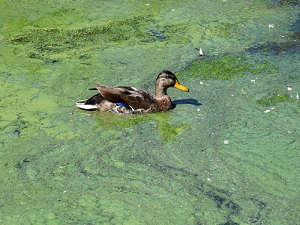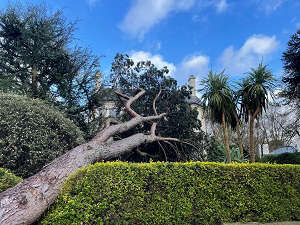
By David Young (PA)
Stormont ministers have agreed an action plan aimed at tackling environmental problems at Lough Neagh.
Noxious blooms of blue-green algae covered large parts of the lough last summer and also affected other waterways and beaches in the region.
The algae has returned this year.
Lough Neagh is the biggest freshwater lake, by surface area, in the UK and Ireland, and supplies 40% of Northern Ireland’s drinking water and sustains a major eel-fishing industry.
Environment minister Andrew Muir had developed the action plan in an attempt to deal with the various environmental issues at the lough.
He had been awaiting the sign off from Executive colleagues to implement the blueprint.
The plan contained 37 actions, 17 of which needed full Executive support.
Mr Muir said the approval was the first step on a journey towards the long term rehabilitation of water quality in the lough.
“I welcome and am grateful to my Executive colleagues for supporting the plan I presented and recognising Lough Neagh as a priority,” he said.
“The publication of the full Lough Neagh Report and Action Plan will be a significant step towards improving water quality, reducing blue green algae and ensuring we can rehabilitate the lough to a healthy status, enjoyed by generations to come.
“The Action Plan is not a wish list,it is a detailed, science-led, proportionate and ambitious set of actions that will make a tangible difference to our waterways.
“I must be clear however, that there are no quick fixes, it will take many years, if not decades to see substantial recovery, such is the depth and complexity of the problem.”
Nitrogen and phosphorus from agricultural fertiliser running off fields is believed to be a major contributory factor in the blue-green algae blooms.
The spread of the invasive zebra mussel species is also understood to have played a role in the blooms, as they have made the water clearer, allowing more sunlight to penetrate, stimulating more algal photosynthesis.
Climate change is another factor cited, with the highest water temperature at Lough Neagh recorded last June.



 Omagh bombing horrors revealed in hearings ‘will educate on effect of terrorism’
Omagh bombing horrors revealed in hearings ‘will educate on effect of terrorism’
 Stormont leaders urge network provider to compensate customers without power
Stormont leaders urge network provider to compensate customers without power
 One person is in a critical following four-vehicle crash on M1
One person is in a critical following four-vehicle crash on M1
 Northern Ireland in ‘eye of the storm’ – O’Neill
Northern Ireland in ‘eye of the storm’ – O’Neill
 Northern Ireland police declare ‘major incident’ as Storm Eowyn approaches
Northern Ireland police declare ‘major incident’ as Storm Eowyn approaches